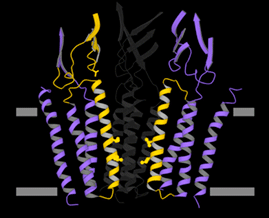This asymmetric gating mechanism controlling the open-or-closed state of the channel is central to fast neuromuscular transmission in all vertebrates. It would have been fine-tuned through evolution to maximise the speed of initiation and termination of the postsynaptic response. In the extracellular domain, the relative displacements are too small to necessitate significant readjustment of non-covalent bonds, which may slow down a conformational change. In the membrane domain, the key to rapid gating movement must be the special architecture that enables the pore-lining helices, mainly by flexing, to alternate the local geometry and chemistry of the pore.

Key publications:
Unwin, N. Nicotinic acetylcholine receptor and the structural basis of neuromuscular transmission: insights from Torpedo postsynaptic membranes. Quart. Rev. Biophys. 46, 283-322 (2013). (pdf)
Unwin, N. Experiments in electron microscopy: from metals to nerves. Physica Scripta 90, 048002 (2015). (pdf)
